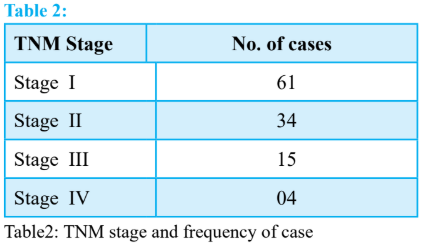Abstract
Background:
Penile cancer is an aggressive and mutilating disease which
deeply affects self-esteem and daily life of the patient. Penile
cancer mostly affects the elderly, seen in people in their sixties
and seventies. Occurrence in younger age is a need of research
of penile neoplasia in young non-circumcised patients.
Materials and Method:
This is a three-year retrospective
study. Data was extracted from the Department of Pathology
and Medical Record section of B.P. Koirala Memorial Cancer
Hospital. All histologically proven cases were included.
The objective of this study was to assess clinical histo-
pathological profile of penile carcinoma.
Results. A total of 114 malignant cases were included out of which most
common age group involved was 50-60 years with mean age
of presentation being 51.6 years. Glans was the commonest
site of involvement in 59 cases (51.7%). Well-differentiated
squamous cell carcinoma was the most common type (71%).
Forty nine patients (43%) presented when the mass size was
4-6 cm and 44 (39%) came with 2-4cm and rest less than 2
cm. Lymphvascular invasion was seen in 15 (13%) out of
114 cases and perineural invasion was seen only in 5 (4.3%)
cases. 20 cases (17.5%) had lymphnodes positive which are
less than 5 lymphnode positive and five (4.3%) had more
than 5 lymphnodes positive.
Conclusion.
Early diagnosis and intervention of the patient ensure high probability of getting
cured because the stage at presentation appears to be the most
vital prognostic indicator for survival.
References
Phillipo L Chalya, Peter F Rambau, Nestory
Masalu ,Samson Simbila. Ten-year surgical
experiences with penile cancer at a tertiary care
hospital in northwestern Tanzania:a retrospective
study of 236 patients. World Journal of Surgical
Oncology 2015,13:71. DOI 10.1186/s12957-
-0482-0
Silva RS, Silva AC,Nascimento SG,Oliveira CM,
Bonfim CV. Demographic and epidemiological
aspects of mortality from penile cancer. Acta
Paul Enferm. 2014;27:44–7.
Maden C, Sherman KJ, Beckmann AM. History
of circumcisions, medical conditions, sexual
activity and risk of penile cancer. J Nat Cancer
Inst.1993;16:1255–7.
Schoen EJ, Oehrli M, Colby C, Machin
G. The highly protective effect of new born
circumcision against invasive penile cancer.
Pediatrics.2000;105:E36.
Tsen HF, Morgenstern H, Mack T, Peters RK.
Risk factors for penile cancer: results of a
population-based case–control study in Los
Angeles County (United States). Cancer Causes
Control. 2001;12:267–77.
Barnholtz-Sloan JS, Maldonado JL, Pow-sang
J, Giuliano AR. Incidence trends in primary
malignant penile cancer. Urol Oncol. 2007 Sep-
Oct;25(5):361-7.
Pettaway CA, Lance RS, Davis JW. Tumors of
the Penis. In: Kavoussi LR, Partin AW, Novick
AC, Peters CA, editors. Campbell's Urology. Vol
10 ed. Philadelphia, PA: Saunders Elsevier;
p. 901-33.
Reis AA, Paula LB, Paula AA, Saddi VA, Cruz
AD. Aspectos clinicoepidemiologicos associados
ao cancer de penis. Cienc Saude Coletiva.
;15:1105–11.
Annual Report, BP Koirala Memorial Cancer
Hospital 2016, 2017.
Protzel C, Alcaraz A, Horenblas S, Pizzocaro G.
Lymphadenectomy in the surgical management
of penile cancer. Eur Urol. 2009 May;55(5):1075-
DOI: 10.1016/j.eururo.2009.02.021. Epub
Feb 23
Lont AP, Besnard AP, Gallee MP, van Tinteren
H, Horenblas S. A comparison of physical
examination and imaging in determining the
extent of primary penile carcinoma. BJU Int
; 91:493-5.
Gupta DK, Luitel BR , Chalise PR, Subedi
PP,Chapagain S, Thakur DK,Sharma UK,
Gyawali PR, Shrestha GK. Clinicopathological
pattern of penile cancer in a tertiary care centre
in Nepal. J Nepal Med Assoc 2015;53(199):162-
Lau D W, Ong C H, Lim T P, Teo C .Penile
cancer: a local case series and literature review.
Singapore Med J 2015; 56(11): 637-640 doi:
11622/smedj.2015174
M. Pahwa, M. Girotra, A. Rautela, R. Abrahim.
Penile Cancer In India: A Clinicoepidemiological
Study. The gulf journal of oncology, July 2012;7-9
Koifman L, Vides A J, Koifman N, Carvalho J
P, Ornell A A. International Braz J Urol; Vol. 37
(2): 231-243, March - April, 2011
A.RandoSous,M.P ́erez-UtrillaP ́erez,A.
A g u i l e r a B a z ́ a n , A . Ta b e r n e r o G o m e z ,
J.CisnerosLedo,andJ.DelaPe ̃naBarthel
Advances in Urology Volume 2009, Article ID
, 3 pages doi:10.1155/2009/415062
OY Szeto, HC Cheng, WM Ng, KC Ngan. Hong
Kong J Radiol. 2016;19:111-7 | DOI: 10.12809/
hkjr1615362
Sufrin, G, Huben, R. Benign and malignant
lesions of the penis. In: Adult and Pediatric
Urology, 2nd ed, Gillenwater, JY (Ed), Year
Book Medical Publisher, Chicago 1991.
Solsona E, Algaba F, Horenblas S, Pizzocaro
G, Windahl T; EAU Guidelines on Penile
Cancer: Eur Urol. 2004; 46: 18. doi:10.1016/j.
eururo.2004.03.007
Slaton JW, Morgenstern N, Levy DA, Santos
MW Jr, Tamboli P, Ro JY: Tumor stage, vascular
invasion and the percentage of poorly differentiated
cancer: independent prognosticators for inguinal
lymph node metastasis in penile squamous
cancer. J Urol. 2001; 165: 1138-42.
McDougal WS: Carcinoma of the penis: improved
survival by early regional lymphadenectomy
based on the histological grade and depth of
invasion of the primary lesion. J Urol. 1995
Oct;154(4):1364-6.

